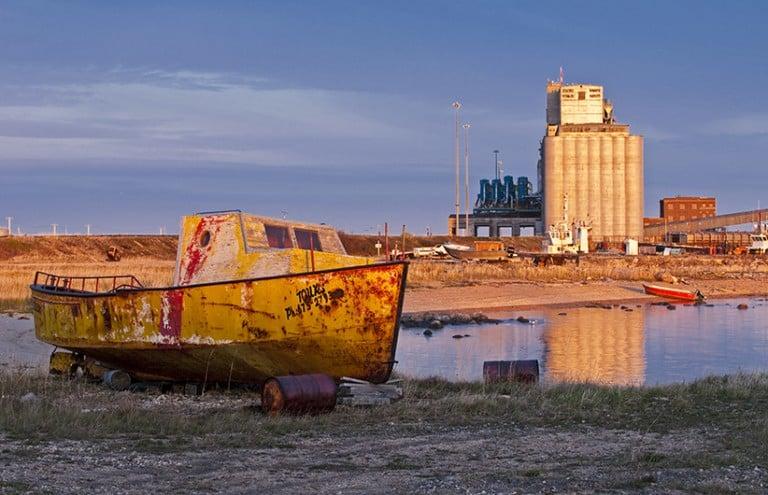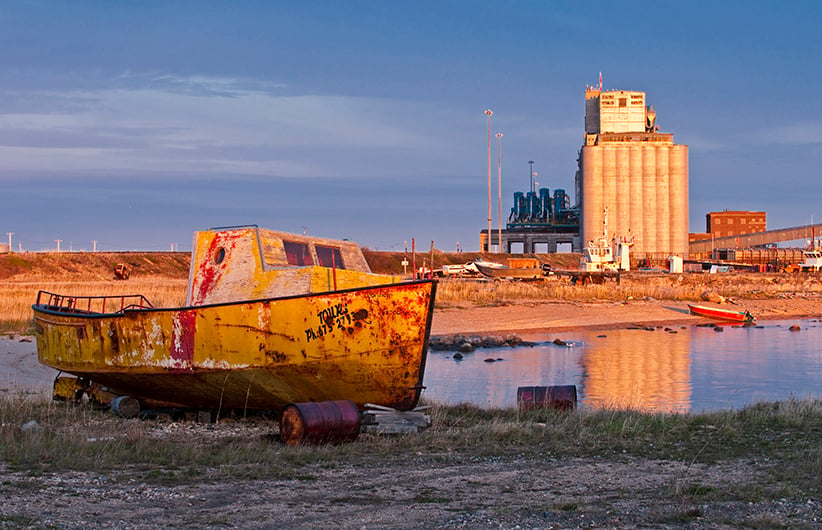How Ottawa abandoned our only Arctic port
Canada’s only Arctic deep-water port is now closed, leaving workers in Churchill puzzled and any talk of Arctic sovereignty feeling like empty rhetoric

An old boat sits on the shore, Port of Churchill, Manitoba, Canada. (Peter Blahut/Getty Images)
Share

I flew up to Churchill in a small private plane, with a map in my lap so I could trace our progress north.
This is a good way to appreciate how vast and empty this country is. Churchill is as far from Winnipeg as Toronto is from Nashville. From the cockpit, on a clear August day, the pilot and I could see for more than 100 km in every direction. It was simply forest, muskeg and hundreds of lakes, most left nameless on my map. But it did show the occasional mine, fishing camp or radio tower, and each of these was marked with the same bracketed annotation: (Abandoned).
RELATED: How to find the centre of Canada
We began our descent just as Hudson Bay appeared on the horizon. The town sits on a narrow point of land bounded by the sea to the north and the Churchill River to the south and west. The first visible landmarks were the grey stone walls of Fort Prince of Wales (abandoned 1782) and the white grain elevators of the Port of Churchill (abandoned 2016).
The massive superstructure of the port is visible from everywhere, and the main street ends right at its gates. When I pulled up in my rental pickup, these were open—the guard shack empty.
Other than the concrete elevators and the loading gantries there was not much to see. A rusting tugboat sits on blocks. There are no train cars waiting to be unloaded, and no ships to take on cargo. Other than seagulls and the wind, it was quiet.
At 4:30 p.m., though, a few people began to emerge and walk toward their cars. This was the last shift, leaving for the last time.
The idea of building a deep-water port on Hudson Bay began in the 19th century. It was conceived as a great nation-building enterprise, a more direct route to Europe, and a strategic gateway giving Canada an indisputable claim to the Arctic. The rail line from The Pas took six years to build, cutting through the forest and over the muskeg. The first grain shipment left in 1931.
In 1997, the Liberal government of Jean Chrétien sold the railroad and port to Omnitrax, based out of Denver. The port soon saw record volumes of exports being shipped to Europe, the Middle East, and even Africa.
Then Stephen Harper’s Conservatives ended the Wheat Board monopoly, and farmers were free to sell their grain to whomever they chose. They chose companies shipping out of Thunder Bay or Vancouver. So the ships stopped coming, and in July Omnitrax announced it was closing the port and ending its rail freight service, too.
FROM OUR ARCHIVES: Want political change? Talk to a farmer
Politicians in Winnipeg and Ottawa protested and demonstrated their concern, but their empathy is little use to people like Kim Kushniryk. She recently earned her millwright ticket, and after being promised another shipping season, she made a down payment on a new truck. But now she and other newly unemployed port workers were on their way to the legion for beers and to figure out what’s next.
The mood was not cheerful, but not despondent either. I sat with a couple of long-time employees and talked about the economics of hauling grain, how the melting permafrost hurts the rail line, and why the Liberals sold the port in the first place.
These workers were, surprisingly, not bitter. Kushniryk almost immediately found work in the garage of a local tour company. Still, she added, “I’m hoping some sort of miracle will go through, maybe the government will buy the port back.”
They know Omnitrax is not responsible for maintaining Canada’s Arctic sovereignty. And most, like Kushniryk, have trades and skills and can find work elsewhere. Still, they were puzzled. Could Ottawa really just abandon Canada’s only deep-water northern port?
The next morning, word spread that a boat had overturned in the bay. I drove back to the now closed port. The river currents, waves and gale winds created a violent, grey, stormy chop in the strait. A whale-watching boat heaved back and forth as it navigated to the shelter of the jetty. Its crew held onto the rail, bracing themselves against the waves and the icy rain. It towed a Zodiac, floating upside down. A knot of people gathered along the quay to watch, in silence.
Despite Canada’s patriotic rhetoric about Arctic sovereignty, there is no Coast Guard here. No icebreakers. No Navy. No port police. The small RCMP detachment doesn’t have a boat. Omnitrax’s tugs are moored to their berth, idle. The harbourmaster only comes up when a freighter is expected. The Transport Canada building is padlocked and empty. There isn’t even a life ring to be found. It may be the only commercial deep-water port in the world without any security or rescue resources, and it’s been like this as long as anyone can remember.
If there’s an emergency in the bay, or in the surrounding wilderness, the people of Churchill are on their own. If a search and rescue aircraft is needed, it must fly in from Trenton, in southern Ontario, 2,000 km away.
This time there was good news. The Zodiac had only one tour guide on board. He capsized right at the harbour mouth, and was able to swim back to shore on his own. This was a welcome miracle. Last month they were not as lucky. A father and his two children, a boy, 4, and a girl, 5, capsized their canoe in the bay. They were wearing life jackets, but the water is only 5° C. Local guides mounted a rescue, but it was still too late for the little girl. She died of hypothermia.
The other end of the main road takes you out of town, past the boarded-up buildings of the naval base HMCS Churchill (abandoned 1968), past a radar installation (abandoned 1970s), to the rocket range (abandoned 1985).
The military first arrived in Churchill in 1943. It built an airstrip so pilots could ferry lend-lease aircraft from factories in the United States, up to Churchill, then Greenland, and ultimately to Britain. After the war the military stayed; as the town grew in strategic importance for both the United States and Canada it became the jumping-off place. They built the Distant Early Warning line from here, a string of radar bases across the Arctic to warn of incoming Soviet bombers. After these became obsolete, the rocket base was built—first to study the northern lights, then to test new propellants. But eventually, this closed, too.
In each case, the Coast Guard, the Navy, the Army, federal researchers and various government departments had perfectly logical reasons to leave. It was the same when Chrétien chose to sell the port and Harper shut down the Wheat Board. There were budget cuts, new priorities, declining needs. But collectively, all these decisions amounted to a totally bizarre and illogical result: Ottawa completely abandoned our only Arctic port.
In the case of the rocket range, a local group lobbied the government to give them the site, and have built the Churchill Northern Studies Institute, a beautiful modern building housing researchers from around the world. The institute is thriving, and is run with only a tiny amount of support from any level of government. But it is ridiculous to suggest their staff of seven have filled the hole left by more than 4,000 Canadian Forces personnel.

I met Mayor Michael Spence for breakfast in the dining room of his hotel, the Seaport. The sun was back, and the main road was bustling with tourists who had just arrived on the passenger train from Winnipeg.
Spence, like the majority of residents, is Indigenous. He comes off as a consummate entrepreneur: energetic, intelligent and enthusiastic about his town. By his estimates, the port was responsible for 30 per cent of the town’s economy, but luckily, the tourism sector accounts for at least twice that. In the ’70s, local businessmen began to market the town as a destination for watching polar bears and the northern lights. They worked hard to build up the market, and now the town would not exist without it.
As soon as Spence heard Omnitrax was leaving, he travelled to Winnipeg and then Ottawa to talk to politicians. They were responsive, but so far, have only made vague promises. He wants the same thing everyone I spoke to wants: for the government to take over the port and then immediately sell it to local stakeholders who depend on the railway and the port: farmers, First Nations reserves, and local businessmen.
I asked if the Prime Minister has ever visited Churchill: No, not yet. The new premier of Manitoba, Brian Pallister, hasn’t either. But a senior Chinese diplomat was up last week to recruit locals interested in Mandarin language training. China is increasingly active in the Arctic; for them, the northern maritime route to Europe is about 6,000 km shorter. Beijing has yet to recognize Ottawa’s sovereignty over the Northwest Passage, which many believe will become increasingly important due to global warming and melting ice. Perhaps this is understandable. The Canadian North is the same size as the European Union but with a population of only 118,000 people—less than the city of Guelph, Ont.
Earlier this year Beijing published a shipping guidebook to Canada’s North, with detailed information on sea ice and weather, and announced it intends to transport cargo through the archipelago soon. China has refused to say whether it will ask Canada’s permission or not.
Either way, we have no choice in the matter. Canada no longer has an ocean-going blue water Navy after years of budget cuts, neglect and shipbuilding delays. The nearest naval base is in Halifax, 4,000 km to the south. And the Coast Guard has only seven icebreakers capable of truly northern operations. None are heavy enough to remain year round. And our force of part-time Canadian Rangers? They are still using Second World War era Lee-Enfield rifles.
RELATED: The sinking of the Canadian Navy
There’s a large inukshuk on a pebble beach behind City Hall where tourists stop for selfies. In recent decades the traditional Inuit landmark, and the North in general, has become a prominent part of our cultural identity. Canadians visit here to be more Canadian—to say they’ve stood on the tundra and photographed polar bears. Our politicians do the same thing, and they know how important the Arctic is to Canadian identity. They fly up, stand by some sled dogs, assure us Canada stretches from “sea to sea to sea,” and declare us an important northern nation.
But the town of Churchill proves these are just lies we tell ourselves. Canada remains huddled next to the U.S. border. Our northern ambitions were abandoned long ago. Now, we project our sovereignty and promote development with nothing more than empty rhetoric.
When Justin Trudeau took office last year he issued his ministers mandate letters containing over 360 different “priorities.” The Arctic was mentioned only twice. One of those, however, was to the minister of defence, commanding him to “renew Canada’s focus on surveillance and control of Canadian territory and approaches, particularly our Arctic regions.”
RELATED: The Trudeau government gives itself a mandate of expectation
If this or previous governments were serious about that, Churchill would unquestionably play a central role. It would have at least one Coast Guard vessel and an icebreaker. There would be a small military base, easily supplied by rail from the south, and able to patrol far into the north. And the bureaucrats in Ottawa would be working hard to use all its assets—a river, a railroad, a port, an airstrip—to connect and support all of our other remote northern communities.
So far, there is no reason to believe this government will be any different than the last. (Asked why the military has no presence in Churchill, a Department of Defence spokesperson said it was “a strategic decision based on how the Navy allocates resources.”) The people of Churchill, and Iqaluit, and Tuktoyaktuk will do their part. The entrepreneurs and the researchers and tour guides will continue to keep towns like Churchill alive. But they will likely remain on their own. They learned they don’t need Canada. But Canada needs them.
Back at the airport, the parking lot was empty and there was no one in the terminal. The population of Churchill has shrunk steadily over the last 30 years and now has fewer than 800 year-round residents. Most of the tourists come by train or by charter, and such a small population can’t keep regular commercial flights full.
There was a large display of black and white photos along one wall, showing the sprawling size of the former military base. There were aerial shots showing block after block of barracks, and interior photos of a stylish officers mess and a bowling alley.
On the tarmac a couple of huge hangars stood empty. We could see the towers of the abandoned rocket range to the south, and in the north, the port’s white grain elevators. We climbed on board, took off, and flew out over the bay. Hundreds of beluga whales were feeding at the mouth of the river. Circling low over Fort Prince of Wales we could see polar bears sunning themselves on the tundra beneath its walls. Then we turned south, and away.